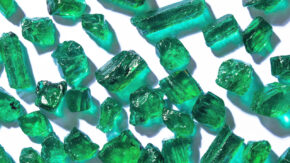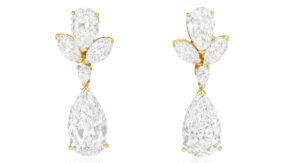RAPAPORT… There’s a legend that shows up in a few different places,
about a renowned explorer — the real Alexander the Great in some books, the
fictional Sinbad the Sailor in others — who is faced with the challenge of
collecting diamonds. The stones sit at the bottom of a shadowy and forbidding
valley, guarded by serpents that, in one colorful version of the story, have
the magical ability to look men in the eye and turn them to stone. The hero has
a plan to lower a mirror into the pit, and sure enough, when the snakes glance
into it, their charm backfires: They petrify themselves. Still, even with the
enemy vanquished, the men are hesitant to climb into the valley. Their leader,
whom they’ve followed deep into the Hindu Kush, has another thought — he’ll
consult the wise men of the region about how best to claim the treasure.
The elders offer strange advice. The hero returns and
instructs the group to throw raw meat into the valley and wait at the top of
the mountain. They do it, and sure enough, the odor attracts a pack of vultures
that swoop down and pick up the meat. As the birds make their ascent, the hero
tells his troops to follow them. The vultures fly overhead and escape, but as
they rise further and further into the air, small pebbles rain down from the sky.
The men scramble to pick them up. To their delight, it’s the diamonds; they
stuck to the raw flesh just long enough to be lifted out of the darkness.
A centuries-old appeal
This account appears everywhere, from the writings of
13th-century Persian scientist and storyteller Zakariya al-Qazwini, to the
dispatches of Marco Polo, to the classic One Thousand and One Nights. But in
the end, it doesn’t really matter whom it’s about or where it came from,
because it’s an entertaining adventure that also reminds us just how long
diamonds have been prized. The message is clear: It’s worth making a stop at a
harrowing snake pit just to gather the crystalline gems.
Diamonds have meant money, prestige and power since at least
the 1200s, when Marco Polo traveled to India and then published books in Europe
about what he saw. They’ve meant plenty of other things, too. Today, as the
story of diamond marketing in the 20th century becomes increasingly well known,
it’s worth looking back at how the stones were perceived before they were being
advertised in the pages of Town & Country, The New Yorker and Vogue. Long
before anyone understood the science behind diamonds or even where to find
them, they were a subject of fascination.
Cross-cultural power
From India to Syria to Rome to Greece, ancient cultures have
ascribed miraculous, otherworldly powers to diamonds, using them in religious
artifacts and, of course, jewelry. Indian maharajahs wore rough diamonds — the
bigger the better — because they thought the stones gave them strength. In the
Middle Ages in Europe, diamonds were thought to have active medical properties,
able to do all sorts of wonderful things: cure diseases, promote fertility and
even end arguments between couples (well, maybe that last one is true). Even though
we know better now, the heart of the deep, cross-cultural diamond tradition
remains as clear — and as relevant — as ever.
A real diamond will always be a little bit mysterious, a
little bit unknowable. Even with all of the resources we have at our fingertips,
we’ll never fully understand the diamond’s astonishing journey. With many now
debating the question of its value, this is a good time to recall the mystique
and inherent beauty that have drawn people to this stone throughout history.
A Brief History of Diamonds
800 to 400 BCE
Diamonds are first discovered on the banks of rivers in
India, where they are called vajra, the word for “thunderbolt”: a reference to
their strength. The stones are used for both currency and ornament, and are
often placed in the foreheads of religious idols (the legend of the notorious
ocean-blue Hope Diamond holds that it was stolen from one such statue — hence
the curse).
77 CE
In Ancient Greece and Rome, diamonds are called adamas,
which means “invincible.” Roman scholar Pliny the Elder writes, “The most
valuable thing on earth is the diamond, known only to kings, and to them
imperfectly.” Pliny explains the stone is so impossible to destroy that first,
it must be weakened by soaking it in goat’s blood.
1200
The long historical connection between Jews and diamonds
begins in the Middle Ages, when people believe that diamond dust is deadly.
Barred from working in other, more desirable trades due to religious
persecution, Jewish men begin learning how to cut the stones.
1429
The art of diamond cutting is now an art form, and one man,
Jacques Coeur, sees an opportunity in Agnes Sorel, the young and
fashionable mistress of King Charles VII of France. Coeur, the king’s financial
adviser and a successful merchant, meets Louis de Berquem in his travels, a
Belgian who has been experimenting with the cut that will become the brilliant.
Coeur thinks de Berquem’s stones are so stunning that women, not just men, will
want to wear them. He convinces Sorel to try it, and she starts a trend.
1910
The story of the Hope Diamond curse catches on in the
American press, after Washington socialite Evalyn Walsh-McLean buys
the blue stone from renowned French jeweler Cartier. The way the legend
tantalizes modern readers shows how mysterious diamonds remain to people, and
how easy it is to believe that a jewel can have special powers.
Image: The Hope Diamond (Alamy Stock Photo)
This article was first published in a special supplement produced in collaboration with the Diamond Producers Association.



